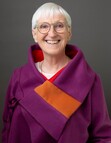Felicity Hayes-McCoy's Blog, page 6
July 23, 2013
Is it Lughnasa or Crom Dubh's Sunday?

You're looking at the face of Crom Dubh, The Crooked Dark One. Depending on which team you batted for in pre-Christian Ireland, he was either Lord of The Harvest or The Bringer of Famine. And a thousand years later, depending on whether you were a Christian convert or a stubborn adherent to the old gods, he was either a pagan wizard banished by holy St. Brendan or a dark and evil deity defeated by the sun god, Lugh.
Across the millennia, his stone image was preserved in the village of Cloghane, at the foot of Mount Brandon here in Corca Dhuibhne. And each year at the turning point between July and August, people climbed the mountain from the east to celebrate his annual festival with bonfires, feasting, dancing, hand-fasting and sacrifice.

Mount Brandon is Corca Dhuibhne's holy mountain. Brendan the Voyager, the medieval saint said to be the first European to reach the New World, began his epic voyage from Brandon Point at the north western end of the peninsula. Before setting out with his companion monks, he's said to have climbed the mountain to prepare himself in prayer. 'Brandon' is an Anglicisation of 'Breannán', the Irish language form of 'Brendan', from whom the mountain takes its present name.
But its older name Slíabh Daghda, The Mountain of The Daghda, reveals its earlier association with the principal god of the ancient Celts. And the festivities that still take place each year on its summit celebrate the Celtic season of Lughnasa, traditionally associated with the sun god Lugh who rode the skies in his burnished chariot drawn by golden horses, and strode up The Daghda's mountain when the corn was ripe, to slay Crom Dubh with his spear of light and protect the harvest for his people.
 The festival of Lughnasa's still celebrated all over Ireland. Its traditional dancing, feasting, bonfires, competitions and music-making easily lending themselves to recreation as arts festivals and tourist attractions: and its association with Lugh makes it easily marketable via the play, and especially the film version, of Brian Friel's Dancing at Lughnasa.
The festival of Lughnasa's still celebrated all over Ireland. Its traditional dancing, feasting, bonfires, competitions and music-making easily lending themselves to recreation as arts festivals and tourist attractions: and its association with Lugh makes it easily marketable via the play, and especially the film version, of Brian Friel's Dancing at Lughnasa.But over the years, and in different places, there’ve been different versions of Lugh’s story. In some versions it's Crom Dubh, not Lugh, who brings the harvest out of darkness to the people. In Cloghane, Crom Dubh's image, preserved in the local church, was said to have brought luck and healing. The festival held in Cloghane village at Lughnasa is still called Domhnach Chruim Dhuibh, which means ‘Crom Dubh’s Sunday. And throughout Corca Dhuibhne, when old people insist they’re right about something, you still hear them saying ‘Dar Chruim’. Once I asked an old man to translate that for me, and he stopped for a bit, looking puzzled. Then he said he supposed it meant ‘by God’. He was right. It means ‘by Crom’.
So, just as pagan gods were displaced by Christian saints, stories about older pagan gods must have been reshaped and retold to make incoming gods more important. Perhaps Lugh defeating Crom is an echo of ancient propaganda, as well as an image of light defeating darkness. ‘Our big sun god beat your crooked dark guy.’ If it is, the propaganda failed. Both stories survived. The festival of Lughnasa celebrates
Lugh’s triumph over Crom Dubh. But in Cloghane it’s still Crom Dubh’s day. And if you ask people why, they’ll tell you that’s just how it is. They’re aware of the contradictions and they’re not fazed by them. To them, what matters is what’s there, because it’s part of the picture. You pass on what you’ve received because it’s your children’s inheritance. What they do with it is up to themselves. All that’s required of them is to pass it on in their turn, remembering that no story is unimportant because each sheds light on the rest.
That's why the end to my story here is so terrible. In August 1993, the stone head that the people of Cloghane had preserved so long was stolen from its place high up in the village church wall. It's never been returned.

Visit The House on an Irish Hillside on Facebook
Published on July 23, 2013 04:30
July 16, 2013
Salad Song.

Nothing beats the pleasure of arriving home to a garden that's suddenly sprung to life in two weeks of sunshine after a slow, chilly start to an Irish summer.
Grass in the orchard high enough to tickle the backs of your knees. Apples swelling on branches and fuchsia flowering on the ditches. Opening windows ... leisurely unpacking ... checking the post ... a little watering ... a beer at sunset ... and then the first home-grown salad of the season.
Broad bean tops. German radishes.Young rocket leaves. Baby spinach leaves. Red clover leaves and flower heads. Chive flowers. Rainbow chard leaves. Parsley flowers and chopped parsley stalk. Beetroot leaves. Marjoram buds and flower heads. Chopped chives. Shredded garlic stalks fried in olive oil with black pudding.
Tossed in a bowl with sunflower oil and cider vinegar. And served at the kitchen table with more beer and crispy ciabatta.

Visit The House on an Irish Hillside on Facebook
Published on July 16, 2013 14:14
June 25, 2013
Strawberries and Cream in a Writer's Dream Venue.
 All my childhood memories of Enniscorthy revolve round fruit and flowers. My grandmother’s house there was built on a hill. I remember roses in the garden, and tall lilies on thick stems, with ivory petals like curled pollen-powdered vellum. Tattered, golden irises, called flags, grew near a row of tumbledown stone sheds. There was a broad, scrubbed step outside the kitchen door and a path ran down the garden to an orchard of apple trees and fruit bushes.
All my childhood memories of Enniscorthy revolve round fruit and flowers. My grandmother’s house there was built on a hill. I remember roses in the garden, and tall lilies on thick stems, with ivory petals like curled pollen-powdered vellum. Tattered, golden irises, called flags, grew near a row of tumbledown stone sheds. There was a broad, scrubbed step outside the kitchen door and a path ran down the garden to an orchard of apple trees and fruit bushes. 
Granny was frail by the time I remember her. There was a starched cloth on the polished table where we had tea when we visited; the cups were her own mother’s sky blue and white china, patterned with flowers. I remember gooseberry and blackcurrant jams made with fruit from the garden, and ‘country butter’ served on slices of her own brown soda bread. The strong taste of the salty butter was almost like cheese.

Each year in June we’d take the train down from Dublin for Enniscorthy’s Strawberry Festival. Bowls and baskets of the locally-grown berries were everywhere.

The steep streets of the town were crowded with locals and visitors. People would take picnics down to the water meadows by the broad river Slaney. And sometimes we did too. Cows grazed there, and I loved the humming of bees in the buttercups.

Coming back from the riverside, we’d climb the steep streets of the town, past the grey stone castle. The castle was closed to the public in those days, but I remember being taken up a winding staircase once, to the top of a tower, and emerging onto the flat roof to watch a golden sunset.
Last year, in Enniscorthy on a book signing tour, I visited the castle again, now beautifully restored and home to a fine museum. It was a hurried visit, tucked in at the end of a busy day, so I didn’t see half of what’s housed there.

And then this year I received an invitation from the Words In Wexford Literary Trail, to speak about my memoir The House on an Irish Hillside at an Afternoon Tea there. What writer could ask for a better venue? At one point in its history, back in the 1500s, it was leased by the poet Edmund Spencer. And, besides, the event is part of this year’s Strawberry Festival. Already I’m fantasizing about scones and whipped cream topped with rich, red Enniscorthy strawberries.

Visit The House on an Irish Hillside on Facebook
Published on June 25, 2013 11:06
June 16, 2013
Thoughts on Father's Day
 My father G.A. Hayes-McCoy and his parents, Galway, 1930s
My father G.A. Hayes-McCoy and his parents, Galway, 1930sWhen I was a child in the 1950s my father worked in the Art and Industrial Division at the National Museum of Ireland. He subsequently became a noted military historian but until I was five or six he was an assistant keeper at the museum, with responsibility for the Military History and the War of Independence collections.
When I visit the museum today I can still feel his presence. He was fascinated by archaeology as well as history and so passionate about Ireland's past that even at that age I learned to share his enthusiasm. It was a passion rooted in a philosopher's sense of the universality of human experience as well as delight in his own cultural inheritance. And, above all, it was founded on a pursuit of truth. Looking back now, I'm aware that his uncompromising insistence on the importance of facts over nationalist sentiment must have made him unpopular in some quarters in the Ireland of his time. But as a child I just loved his stories. Not that I grasped many facts at the age of five of six. Instead I received a kaleidoscope of impressions, a sense of excitement and drama, colour and texture, discovery and delight. It's lived with me ever since.
I remember him lifting me up to admire Iron Age ring-beads of translucent black glass with spiral yellow inlay, and twisted gold collars with gorgeous fluted ends. There were amber beads and inlaid boxes too, enamelled horse-bits, jet ornaments, and ceremonial trumpets. Unlike their later, medieval counterparts who laboured over complicated strap-work and heavy decoration, Iron Age craftsmen produced works that are almost modernist in their simple clarity.
That early experience in the museum sparked a lifetime's ambition to achieve the same simple clarity in my writing. It also produced a misunderstanding that, in hindsight, has clarified my understanding of my father as an historian.
 The Broighter Boat (photo courtesy of the National Museum of Ireland)
The Broighter Boat (photo courtesy of the National Museum of Ireland)Among the artefacts in the museum is a little boat which was probably a votive offering to Mannanán Mac Lír, the ancient Celtic sea god. It’s a perfect model of a sea-going version of a naomhóg, the slender, curved coracle still used round the west coast of Ireland, where I live today. About seven inches long and fashioned in beaten gold, it was ploughed out of a field in 1896, by a farmer whose name was Tom Nicholl.
Several little objects were found with the boat, one of which I saw in my childhood as a slender, golden spear. To me that made sense. I knew from stories about ancient Irish voyagers that saints and explorers hunted whales for food. And I’d been told that the Celtic sun god, Lugh, wore a golden collar and carried a spear of light. So I imagined Lugh and Mannanán sailing the golden boat to towards the western horizon and finding the Isles of The Blessed.
I know now that the object I saw as a spear was actually a model of the steering oar that guided sea-going naomhóga.
I know too that no offering’s ever been found that links the Celtic sea and sun gods as neatly as I linked them then in my imagination.
But I also know that imagination itself, balanced by discipline and meticulous research, has a vital place in our understanding of the past.
It's a lesson I learned from a father whose own rigorous, uncompromising scholarship was informed by an imaginative awareness of the universality of human experience.
 My mother, father and me, O'Connell St. Dublin, 1960s
My mother, father and me, O'Connell St. Dublin, 1960sVisit The House on an Irish Hillside on Facebook
Published on June 16, 2013 12:07
May 30, 2013
A Time For Listening.
A cold, wet spring after a cold wet winter. And now a cold, late summer after the slow coming of spring.

Snow on Mount Brandon at Easter. No growth in the grass. Furze and fuchsia bushes slow to flower and primroses still starring the ditches in the last week of May.

For the last three years the rhythm of the seasons has faltered and the certain swing of one thing to the next thing has changed. Now, with livestock crying out for fodder, farmers are shaking their heads and talking of bankruptcy. Here in Corca Dhuibhne, the price of bought-in fodder is high and all over the country the effects of this year's weather are being factored into predictions for next year's profits and losses.
In pubs and shops, and on the roads when people stop to chat with their neighbours, there's talk of selling up and shipping out. Emigration's always been a quick-fix here in Ireland: but now shoulders are being shrugged. The weather's wrong everywhere, they say. There are floods in England and Europe, tornadoes in America, earthquakes, drought and famine all over the world. Food prices are high and, in the current global recession, jobs are scarce wherever you go.
The other morning Radio Kerry ran a story about a priest who's urged people to come together and pray for a change in the weather. I've heard people talk about that since, and not many have laughed. Beneath the talk of prices and recession lies a visceral dread, rooted in shared race-memory, existing at an unconscious level, and all the more powerful for that. What if the sun never shines again? What if all the animals die and the earth ceases to yield?
For thousands of years, the pre-Christian peoples of this peninsula responded to the changing seasons with ritual gatherings and prayers. Their purpose was to channel the energy of the universe and promote the turning cycle of the year. In the Ancient Celtic worldview, each element of the universe is animated by the same pulse of energy and everything in the universe shares a living soul. And in the Celts' circular image of eternity, each thing follows the next in its allotted sequence, like the notes of a tune or the steps in a dance. So for our ancestors, the steady rhythm of seed time followed by harvest time was a sign that the universe was in balance and good health.
And that, I think, is the key. Somewhere deep in our shared consciousness is an instinct that tells us we live in a joined up universe. Increasingly it's becoming evident that the continuing health of the planet depends on our husbandry of it, and it's equally clear that the models we currently live by just don't work.

I've nothing against praying for a change in the weather. But I think it might help if we looked first at our Celtic ancestors' worldview, and considered the nature of the gods that they imagined.
That's not something that's hard to do. Indigenous peoples all over the world still hold versions of that worldview.
 I think we'd be wise to listen to what they have to say.
I think we'd be wise to listen to what they have to say.
Visit The House on an Irish Hillside on Facebook

Snow on Mount Brandon at Easter. No growth in the grass. Furze and fuchsia bushes slow to flower and primroses still starring the ditches in the last week of May.

For the last three years the rhythm of the seasons has faltered and the certain swing of one thing to the next thing has changed. Now, with livestock crying out for fodder, farmers are shaking their heads and talking of bankruptcy. Here in Corca Dhuibhne, the price of bought-in fodder is high and all over the country the effects of this year's weather are being factored into predictions for next year's profits and losses.
In pubs and shops, and on the roads when people stop to chat with their neighbours, there's talk of selling up and shipping out. Emigration's always been a quick-fix here in Ireland: but now shoulders are being shrugged. The weather's wrong everywhere, they say. There are floods in England and Europe, tornadoes in America, earthquakes, drought and famine all over the world. Food prices are high and, in the current global recession, jobs are scarce wherever you go.
The other morning Radio Kerry ran a story about a priest who's urged people to come together and pray for a change in the weather. I've heard people talk about that since, and not many have laughed. Beneath the talk of prices and recession lies a visceral dread, rooted in shared race-memory, existing at an unconscious level, and all the more powerful for that. What if the sun never shines again? What if all the animals die and the earth ceases to yield?
For thousands of years, the pre-Christian peoples of this peninsula responded to the changing seasons with ritual gatherings and prayers. Their purpose was to channel the energy of the universe and promote the turning cycle of the year. In the Ancient Celtic worldview, each element of the universe is animated by the same pulse of energy and everything in the universe shares a living soul. And in the Celts' circular image of eternity, each thing follows the next in its allotted sequence, like the notes of a tune or the steps in a dance. So for our ancestors, the steady rhythm of seed time followed by harvest time was a sign that the universe was in balance and good health.
And that, I think, is the key. Somewhere deep in our shared consciousness is an instinct that tells us we live in a joined up universe. Increasingly it's becoming evident that the continuing health of the planet depends on our husbandry of it, and it's equally clear that the models we currently live by just don't work.

I've nothing against praying for a change in the weather. But I think it might help if we looked first at our Celtic ancestors' worldview, and considered the nature of the gods that they imagined.
That's not something that's hard to do. Indigenous peoples all over the world still hold versions of that worldview.
 I think we'd be wise to listen to what they have to say.
I think we'd be wise to listen to what they have to say.Visit The House on an Irish Hillside on Facebook
Published on May 30, 2013 08:08
April 23, 2013
St. George's Day at Borough Market - more Circles Links and Layers.

The legend of St. George belongs to England. I remember standing under a statue of him when I first came to London as a child, admiring the dashing knight in armour on his rearing horse, poised to slay the fierce, curly-tailed dragon that was snarling at his feet.
 It was years later that I discovered that St. George belongs to many other countries as well, including Catalonia, a region proud of its Celtic cultural roots, where his feast day's known as La Diada de Sant Jordi. But it's only since moving to Bermondsey that I've discovered the Catalan tradition of giving a rose and a book to a loved one on Sant Jordi's Day.
It was years later that I discovered that St. George belongs to many other countries as well, including Catalonia, a region proud of its Celtic cultural roots, where his feast day's known as La Diada de Sant Jordi. But it's only since moving to Bermondsey that I've discovered the Catalan tradition of giving a rose and a book to a loved one on Sant Jordi's Day.

And then today, wandering round Borough Market, I discovered the link between St. George's Day, which is April 23rd, and UNESCO's International Day of the Book, which falls on the same date because of that Catalan tradition, and because it was the date of the death - and possibly the anniversary of birth - of both the English playwright William Shakespeare and the Spanish author Miguel de Cervantes.

 Borough Market is London's oldest market specialising in food and drink. There was Catalan produce for sale there today and visitors from Catalonia handed out red roses to the shoppers.
Borough Market is London's oldest market specialising in food and drink. There was Catalan produce for sale there today and visitors from Catalonia handed out red roses to the shoppers.

It's a glorious mix of local and international specialities reflecting London's cosmopolitan tastes and traditions. There were knights in chain mail selling artisan British Charcuterie.
The stalls were decked with flags and bunting, and everywhere there were red St. George crosses.


 It was a wonderful demonstration of how new traditions can be sparked by older ones, and of how the same legend can be common to more than one culture. And for me there were even echoes of this year's Scoil Cheoil an Earraigh in Ballyferriter, when Galician piper Anxo Lorenzo marched through the village celebrating the links between Corca Dhuibhne and Galicia's shared Celtic inheritance.
It was a wonderful demonstration of how new traditions can be sparked by older ones, and of how the same legend can be common to more than one culture. And for me there were even echoes of this year's Scoil Cheoil an Earraigh in Ballyferriter, when Galician piper Anxo Lorenzo marched through the village celebrating the links between Corca Dhuibhne and Galicia's shared Celtic inheritance.  But some things remained quintessentially English.
But some things remained quintessentially English.Visit The House on an Irish Hillside on Facebook
Published on April 23, 2013 01:14
April 21, 2013
Celebrating St George's Day in Borough Market - More Circles, Links and Layers.

The legend of St. George belongs to England. I remember standing under a statue of him when I first came to London as a child, admiring the dashing knight in armour on his rearing horse, poised to slay the fierce, curly-tailed dragon that was snarling at his feet.
 It was years later that I discovered that St. George belongs to many other countries as well, including Catalonia, where his feast day's known as La Diada de Sant Jordi. But it's only since moving to Bermondsey that I've discovered the Catalan tradition of giving a rose and a book to a loved one on Sant Jordi's Day.
It was years later that I discovered that St. George belongs to many other countries as well, including Catalonia, where his feast day's known as La Diada de Sant Jordi. But it's only since moving to Bermondsey that I've discovered the Catalan tradition of giving a rose and a book to a loved one on Sant Jordi's Day.

And then today, wandering round Borough Market, I discovered the link between St. George's Day, which is April 23rd, and UNESCO's International Day of the Book, which falls on the same date because of that Catalan tradition, and because it was the date of the death - and possibly the anniversary of birth - of both the English playwright William Shakespeare and the Spanish author Miguel de Cervantes.

 Borough Market is London's oldest market specialising in food and drink. There was Catalan produce for sale there today and visitors from Catalonia handed out red roses to the shoppers.
Borough Market is London's oldest market specialising in food and drink. There was Catalan produce for sale there today and visitors from Catalonia handed out red roses to the shoppers.

It's a glorious mix of local and international specialities reflecting London's cosmopolitan tastes and traditions. There were knights in chain mail selling artisan British Charcuterie.
The stalls were decked with flags and bunting, and everywhere there were red St. George crosses.


It was a wonderful demonstration of how new traditions can be sparked by older ones, and of how the same legend can be common to more than one culture. And for me there were even echoes of this year's Scoil Cheoil an Earraigh in Ballyferriter, when Catalan piper Anxo Lorenzo marched through the village celebrating the links between Corca Dhuibhne and Catalonia's shared Celtic inheritance.


But some things remained quintessentially English.
Visit The House on an Irish Hillside on Facebook
Published on April 21, 2013 13:59
March 29, 2013
Easter on The Dingle Peninsula.

Jack says he doesn't know if anyone had chocolate eggs at Easter when he was a child. Round here they used to boil a big pot of newlaid eggs on Easter morning and compete to see who could eat the most of them. One man was said to have eaten twenty. There was a boy who claimed he'd had six hen's eggs, two duck eggs and a goose egg for his breakfast.
I sat at Jack's table and we agreed that they wouldn't do it now. They'd have chocolate bunnies.
Here in Corca Dhuibhne, the peak of Mount Brandon's still crowned with ice but below in the valleys the earth's waking to springtime.



New traditions replace old ones and across continents and millennia the symbols shift and change. But this is the time of year when they all speak of death and resurrection, seedtime and harvest time, life in the earth, fire in the sun, and the power of the moon over water.
Once, before Easter was ever thought of, the egg was a potent symbol of fertility, strong enough to invoke a blessing or call down a curse.
Once, before he became a chocolate bunny in foil wrapper, the hare was a servant of the Goddess.
 He carried her messages to us from the moon.
He carried her messages to us from the moon.Visit The House on an Irish Hillside on Facebook
Published on March 29, 2013 10:43
March 20, 2013
Spring Equinox on the Dingle Peninsula
The earth is waking
 Primroses and celandines gleam under briars on the ditches.
Primroses and celandines gleam under briars on the ditches.  Furze smells like coconut when the sun warms its yellow flowers.
Furze smells like coconut when the sun warms its yellow flowers. Snow lies thick on Mount Brandon, but the hills and valleys below are green with new grass.
Snow lies thick on Mount Brandon, but the hills and valleys below are green with new grass.
 This year Easter falls only two weeks after St. Patrick's Day and between the two is the Spring Equinox, when day and night are in balance and the wheel of the year turns again towards light, life and fertility.In ancient Ireland at the turn of the year, fires were lit on the mountains and offerings were made to the Good Goddess and her consort the Sun God, to bless the earth and bring luck to seed time and harvest time.
This year Easter falls only two weeks after St. Patrick's Day and between the two is the Spring Equinox, when day and night are in balance and the wheel of the year turns again towards light, life and fertility.In ancient Ireland at the turn of the year, fires were lit on the mountains and offerings were made to the Good Goddess and her consort the Sun God, to bless the earth and bring luck to seed time and harvest time.
Beneath last weekend's rituals in honour of St. Patrick were echoes of those older rites.

And this evening, high on Mount Brandon, the sunset glowed like a ritual fire .
Visit The House on an Irish Hillside on Facebook
Published on March 20, 2013 13:40
March 15, 2013
Memory and Potential on St. Patrick's Day
Ok, so this is the story...
'Patrick approached the High King's fort at Tara where the Druids stood by the chair of the High King. And every fire in Ireland was quenched that night. The druids had called up darkness and shrouded the hills in mist. Because there was a law that no fire should burn on the eve of the festival of Bealtine, when the druids themselves lit a fire to their pagan gods.'
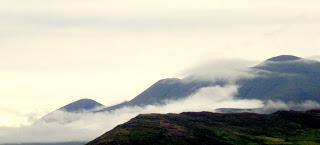
'But Patrick came to the Hill of Slane and lit a fire there and prayed for the people of Ireland. The druids saw the flames of his fire from the height of the Hill of Tara, and they spoke to the High King and told him that Patrick should be killed. But Patrick came to the Hill of Tara from the Hill of Slane and he praised God there and told the High King of God's goodness. And the High King fell to his knees.'
'Then Patrick took a shamrock that was growing on the hill. The shamrock had three leaves on a single stem. And Patrick showed it to the druids and taught them the wonder of the Holy Trinity, that three persons existed in one God, truly distinct and equal in all things, the Father, the Son and the Holy Spirit. And the druids were amazed and fell to their knees and worshipped God.'
Generations of Irish children grew up with that story, passed on from generation to generation, in churches, by firesides and in schools. I remember it from my first picture book in which Patrick towered above the dark-faced druids with firelight behind him and the shamrock held aloft. Behind the druids the high king knelt by his carved throne. And behind the throne a man with a gold harp, with his head bowed, was holding the palms of his hands on the harpstrings to silence its pagan music.
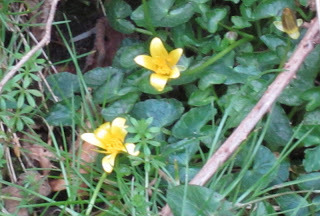
But, as always, the truth's more complex than the legend. Though the legend contains echoes of the truth.
Last night, in Dublin, hi-tech green 'doodles' were projected on the buildings and the flickering, dancing images went viral on the internet. On Sunday there'll be parades in cities from Cork to Chicago and from Boston to Beijing. Green flags, gold harps and three-leaved shamrocks, dancing, drinking and celebration - the whole world's going green this weekend for St. Patrick, the bearded bishop in the green robes with his fistful of shamrock and his gleaming golden crozier.
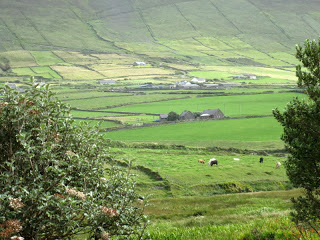
But meanwhile, on the hills and in the valleys of Ireland, the earth itself is going green. And this was the wonder celebrated by the druids. For the ancient Celts, the ritual fire kindled in darkness at the feast of Bealtaine symbolised the triumph of light over darkness in the return of seedtime and the sun.
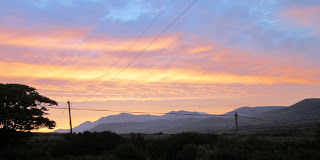
They too gathered to celebrate with dancing and music, parades, religious rites and wild parties. But they needed no explanation of the concept of a triple-aspect deity. Their own vision of springtime was contained in the image of a triple-aspect goddess, the Maiden, the Mother and the Crone. She was memory and potential, childhood, maturity and old age. Here in Corca Dhuibhne her name was Danú. Elsewhere she has other names. But everywhere it's her marriage to the Sun God that brings balance to the universe and fertility back to the earth.
This week a new pope was elected in Rome, the centre of the faith which Christian missionaries like Patrick brought to Ireland. This St. Patrick's Day I'll be thinking about memory and potential.
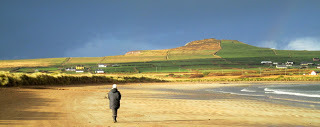
Visit The House on an Irish Hillside on Facebook
'Patrick approached the High King's fort at Tara where the Druids stood by the chair of the High King. And every fire in Ireland was quenched that night. The druids had called up darkness and shrouded the hills in mist. Because there was a law that no fire should burn on the eve of the festival of Bealtine, when the druids themselves lit a fire to their pagan gods.'

'But Patrick came to the Hill of Slane and lit a fire there and prayed for the people of Ireland. The druids saw the flames of his fire from the height of the Hill of Tara, and they spoke to the High King and told him that Patrick should be killed. But Patrick came to the Hill of Tara from the Hill of Slane and he praised God there and told the High King of God's goodness. And the High King fell to his knees.'
'Then Patrick took a shamrock that was growing on the hill. The shamrock had three leaves on a single stem. And Patrick showed it to the druids and taught them the wonder of the Holy Trinity, that three persons existed in one God, truly distinct and equal in all things, the Father, the Son and the Holy Spirit. And the druids were amazed and fell to their knees and worshipped God.'
Generations of Irish children grew up with that story, passed on from generation to generation, in churches, by firesides and in schools. I remember it from my first picture book in which Patrick towered above the dark-faced druids with firelight behind him and the shamrock held aloft. Behind the druids the high king knelt by his carved throne. And behind the throne a man with a gold harp, with his head bowed, was holding the palms of his hands on the harpstrings to silence its pagan music.

But, as always, the truth's more complex than the legend. Though the legend contains echoes of the truth.
Last night, in Dublin, hi-tech green 'doodles' were projected on the buildings and the flickering, dancing images went viral on the internet. On Sunday there'll be parades in cities from Cork to Chicago and from Boston to Beijing. Green flags, gold harps and three-leaved shamrocks, dancing, drinking and celebration - the whole world's going green this weekend for St. Patrick, the bearded bishop in the green robes with his fistful of shamrock and his gleaming golden crozier.

But meanwhile, on the hills and in the valleys of Ireland, the earth itself is going green. And this was the wonder celebrated by the druids. For the ancient Celts, the ritual fire kindled in darkness at the feast of Bealtaine symbolised the triumph of light over darkness in the return of seedtime and the sun.

They too gathered to celebrate with dancing and music, parades, religious rites and wild parties. But they needed no explanation of the concept of a triple-aspect deity. Their own vision of springtime was contained in the image of a triple-aspect goddess, the Maiden, the Mother and the Crone. She was memory and potential, childhood, maturity and old age. Here in Corca Dhuibhne her name was Danú. Elsewhere she has other names. But everywhere it's her marriage to the Sun God that brings balance to the universe and fertility back to the earth.
This week a new pope was elected in Rome, the centre of the faith which Christian missionaries like Patrick brought to Ireland. This St. Patrick's Day I'll be thinking about memory and potential.

Visit The House on an Irish Hillside on Facebook
Published on March 15, 2013 03:58

